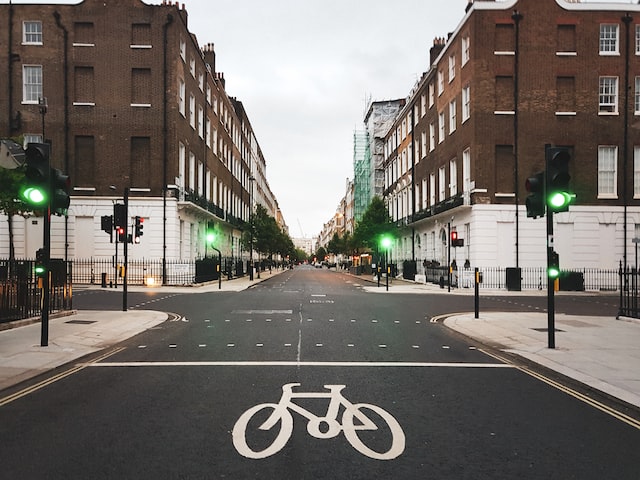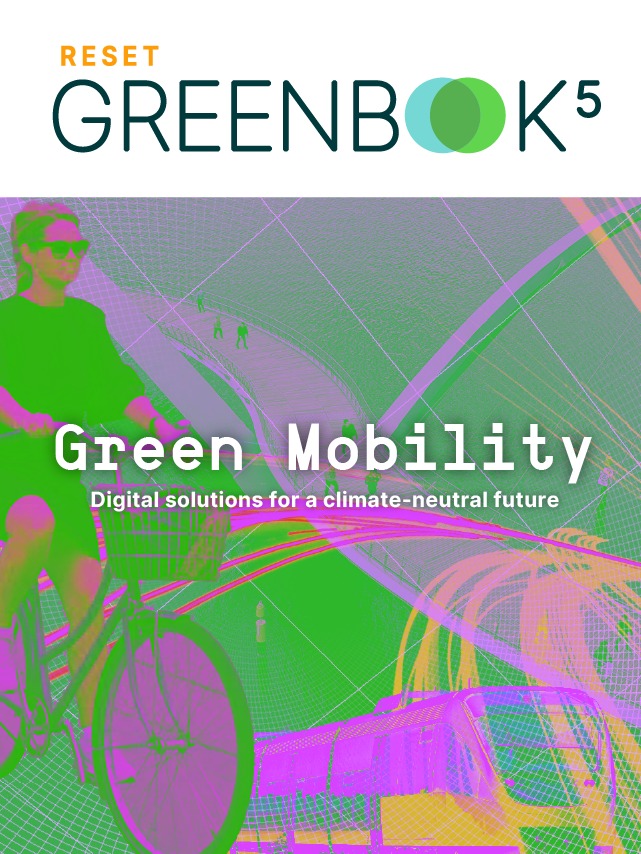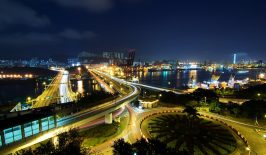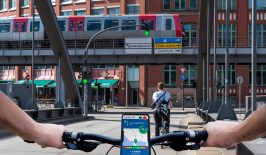Whether by car, train, ship or plane — the movement of people and goods always causes emissions. The transport sector, currently mainly driven by fossil fuels, contributed to around 37 percent of EU greenhouse emissions in 2019, up from 24 percent in 2000. In 2018 alone, cars and the like were responsible for around 888 million tonnes of greenhouse gases in the EU, 62 percent of which came from cars and motorcycles.
The effects are dramatic: the high CO2 emissions not only massively fuel the climate catastrophe, but the never-ending avalanche of cars floods streets and public spaces, impacts health through noise and air pollution, destroys ecosystems and consumes vast amounts of energy-intensive resources such as aluminium, steel and plastic.
Green Mobility – Digital solutions for a climate-neutral future
Autonomous vehicles, e-mobility, AI-controlled traffic planning, new modes for moving from A to B — what will the mobility of tomorrow look like?
We present the digital solutions being proposed for climate-neutral transport and logistics and discuss the new challenges of “digital mobility” in this dedicated special feature.
The Climate Clock is Ticking
The EU Commission aims to significantly reduce carbon dioxide emissions from road transport by 2030, although progress is slow, if at all. While total carbon dioxide emissions in the EU have fallen by 23 percent since 1990, carbon dioxide emissions from road transport have increased by 24 percent over the same period. This is particularly concerning when considering that the European Parliament has called for a 60 percent reduction in overall greenhouse gas emissions by 2030. This reduction is predicted to be essential for keeping the planet under the 1.5 percent Celsius global temperature rise threshold as stipulated in the Paris Climate Accord.
Nevertheless, transport continues to bring up the rear in much of Europe’s already unenthusiastic climate protection efforts. Industry and politics often ignore the need for a fundamental shift in mobility and continue to promote precisely those structures that are responsible for the majority of transport emissions.
There is a broad consensus in the scientific community that CO2 emissions from transport can only be reduced through a radical shift away from private motorised transport to the environmental alliance of local public transport, cycling and walking. Luckily, there are a few early innovators.
Ghent, Brussels, Oslo — The Cities Leading the Way
Die Innenstadt von Gent ist komplett autofrei. Möglich macht das ein Mix aus weitreichenden Maßnahmen: Der motorisierte Verkehr läuft über Schleifen um die Innenstadt herum, am Innenstadtrand darf für maximal 30 Minuten geparkt werden, die Parkhäuser nahe der Innenstadt kosten für 24 Stunden 30 Euro, Since its ambitious circulatieplan in 2017, the city centre of Ghent has been completely car-free. This was made possible by a mix of far-reaching measures: motorised traffic runs in loops around the city centre, parking is allowed for a maximum of 30 minutes on the outskirts of the city centre, parking garages near the city centre cost 30 EUR for 24 hours, however car-sharing cars pay nothing. Children up to 15 years of age can travel free on public transport and new wide cycle paths and the pedestrian zone have been expanded. Transport within the city is often done by cargo bike. Even if not everyone was enthusiastic from the start, the overall response has been positive; the share of cars has fallen from 55 to 39 percent and cycling has almost doubled. There are significantly fewer accidents and traffic jams in the city centre of Ghent and birds can be heard again.
Other cities have also taken similarly proactive measures. In Copenhagen, two thirds of all journeys are made by bicycle and Vienna not only has a well-developed network of cycle paths, but also a good local transport system. Residents of the Austrian city are mobile all year round with the 365 EUR ticket, and nationwide with the 1,095 EUR flat rate since October 2021. While this might seem like a lot to pay in one go, it’s worth pointing out that running a car racks up around 8,000 EUR per year in inspections and maintenance alone, not to mention 1.7 EUR per litre for fuel. In Estonia’s capital, Tallinn, as well as Luxembourg and Malta, public transport is free.
Other cities such as Brussels, Paris, Helsinki and Oslo have also forged ahead, while some German cities such as Cologne and Halle have also set out to largely rid their city centres of cars. With the reduction in traffic, noise and emissions comes immediate shared results. IN these cities, locals are rediscovering streets and squares as public places to linger and play.
Framework Conditions and Levers for Climate-Neutral Mobility
So far, examples like these are individual rays of hope that are the result of the initiative of very ambitious decision-makers and initiatives. However, this does not yet mean that a real, nationwide mobility revolution has been initiated. This can only succeed if the current framework conditions are changed as a first step. In particular, a reform of transport law and integrated transport planning in Europe is needed.

A New Way of Planning Traffic
Essentially, current road traffic laws are designed to ensure that motorised traffic flows safely and easily. Meanwhile, climate protection is not taken into significant account. However, in order to bring down transport-related CO2 emissions, climate protection must be firmly anchored and municipalities must be given more scope to decide how to implement a local traffic transition. Above all, car traffic must not be given a higher priority than the safety of cycling and walking.
Furthermore, integrated planning of transport infrastructure is needed at higher governmental levels, which above all takes into account infrastructures for more climate protection. This also includes realigning the financing conditions for roads, railways and waterways and charging external climate and environmental costs to the users of the infrastructure according to the polluter-pays principle.
In addition — as seen in the example of the city of Ghent — a mixture of measures is needed to both restrict fossil fuel transport and simultaneously favour alternative modes of transport — so-called ‘push-and-pull’ measures. The EU Council and Parliament has earmarked 25 billion EUR for a continent wide reformation of transport, including revising rules on heavy vehicles, developing local transport infrastructure, promoting rail travel and rail passenger rights and the development of post-fossil fuels. The important thing here is that where car transport is restricted, a reliable and environmentally friendly substitute is available to distribute mobility opportunities fairly — and this can only succeed with an active, forward-looking policy.
In implementing many of these measures, one of the greatest transformations of our time could also have a major influence: the digital transformation.
Digitalisation Can Accelerate Climate-Neutral Mobility
The widespread use of smartphones and mobile internet has already ensured that a multitude of new modes of transport and business models have emerged in the mobility sector. Car and bike sharing, e-scooters, taxi platforms, ride-sharing and ride-pooling platforms are greatly expanding the range of mobility options, especially in cities. Meanwhile, new mobility platforms have been developed to help road users find their way around the increasingly complex mobility market. With the idea of “Mobility-as-a-Service” (MaaS), companies such as Google Maps, Moovit or Free Now bundle sharing offers driving services and public transport by displaying various transport options to users via apps as well as allowing for convenient cash-less payment. Although these platforms are largely maintained by private companies, some municipal transport companies are also getting in on the act. Berlin has Jelbi, Paris Bonjour RATP and Amsterdam Amaze — all Maas platforms in public ownership.
Big data analytics, predictive algorithms and artificial intelligence could also make it easier in the future to better align public transport, footpaths and cycle paths with actual use. Additionally improved traffic flows and multimodal travel can be promoted by linking a wide range of data — geodata, traffic data, weather data — to intelligent transport planning. But digital technologies do not only offer new solutions in passenger transport; tomorrow’s logistics could also be made more efficient — and in the best case, less resource-intensive — for example by making full use of capacities through intelligent planning and networking and route optimisation.
This means that the linking of transport and communication is also becoming increasingly important from an ecological perspective. At the same time, new solutions also bring new challenges: e-scooters turn many a pavement into an obstacle course, mobility platforms in private hands create further monopolies as the “Amazon of mobility” and electromobility has an environmental problem with heavy lithium-ion batteries.
In the coming weeks, we will present sustainable digital solutions with the RESET Greenbook: “Mobility Transition — Shaping Climate-Friendly Mobility with Digital Solutions”. We will explore how transport, locomotion and logistics can be made climate-neutral, new innovative low-carbon transport designs and the challenges created by the intersection of mobility and digitisation.











